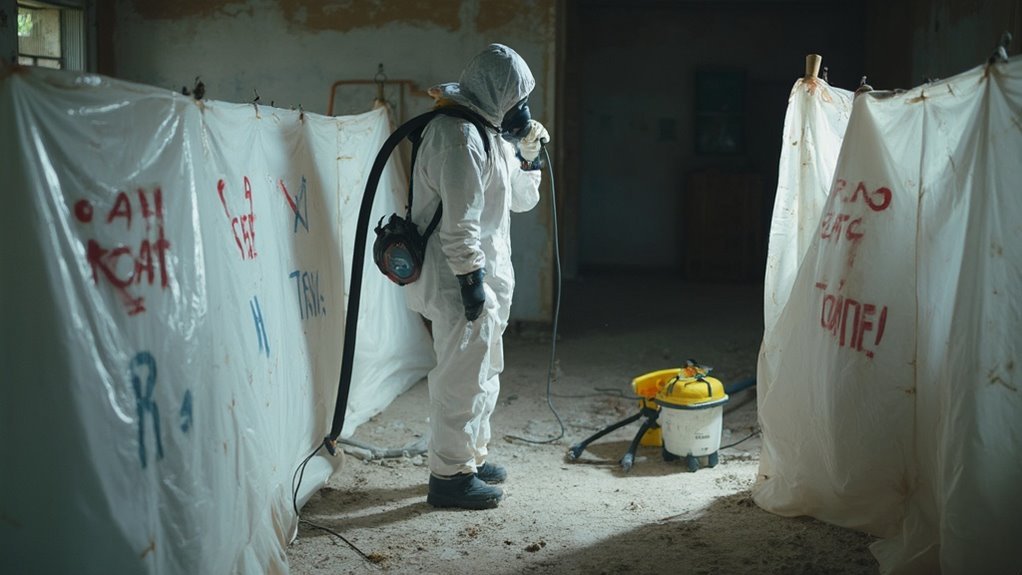To safely eliminate asbestos from your home, start by hiring licensed professionals for a thorough inspection and sampling. Equip yourself with personal protective gear, and seal off the work area with plastic sheeting. Wet down the asbestos materials prior to removal to minimize dust. Carefully extract the materials using proper tools, sealing them in leak-tight containers. Follow up with rigorous decontamination using HEPA vacuums and wet cleaning methods. Finally, confirm safe disposal at an EPA-authorized site. Complying with legal guidelines is crucial for safety. You'll uncover more important steps and tips for effective abatement as you investigate further.
Preparing for Asbestos Removal

Starting the asbestos removal process requires careful preparation to guarantee safety and compliance. First, you need to conduct a thorough asbestos inspection by a licensed professional. This initial inspection is vital to identify and confirm the presence of asbestos in materials like insulation, roofing shingles, and floor tiles. Once suspected areas are identified, sampling is necessary. Collect samples from suspected materials and send them to a laboratory for analysis.
After obtaining results, a professional should conduct a risk assessment to evaluate the extent of asbestos contamination, which is crucial for ensuring ongoing compliance with safety regulations. This assessment guides your next steps and informs the necessary safety measures. You must document all findings, including inspection and sampling results, to keep detailed records. Asbestos-related diseases may take years to manifest, making it crucial to act promptly upon identifying asbestos.
Before beginning the removal process, clear the area of personal belongings and seal off work zones with plastic sheeting. Shut down HVAC systems to prevent airborne contamination. Depending on the situation, consider temporary relocation for occupants. By meticulously following these steps, you guarantee a well-organized, safe environment for asbestos removal, setting the stage for effective abatement.
Safety Precautions for Abatement
When tackling asbestos abatement, it's crucial to prioritize safety precautions to protect yourself and others. Start by equipping yourself with personal protective gear. Use a half-face respirator fitted with a class P1 or P2 filter cartridge, and wear disposable coveralls to prevent contamination of your clothing. Don't forget disposable gloves and a hat to shield your skin and hair from asbestos particles.
Next, guarantee worksite isolation. Seal the work area with plastic sheeting to prevent the spread of fibers, and inform your neighbors to close windows and doors during the process. Cover outdoor areas with heavy-duty plastic to catch debris, and turn off HVAC units to avoid circulating asbestos fibers.
Before beginning any work, remove personal items from the area, including play equipment and vehicles, to minimize contamination risk. Wet down asbestos materials using low-pressure water or a 1:10 PVA solution to keep dust at bay. Finally, after completing the task, use wet cleanup tools and HEPA filter vacuums to capture any remaining particles, guaranteeing a thorough decontamination of the area. Additionally, consider hiring certified experts to ensure that all safety protocols are followed effectively during the abatement process.
Asbestos Removal Procedures

After taking the necessary safety precautions, you can proceed with the asbestos removal procedures. Begin by verifying that the work area is prepared: remove all personal belongings and seal the area with plastic sheeting and negative air pressure units. This will help prevent asbestos fibers from spreading during the removal process.
Using effective asbestos testing techniques, identify the specific locations of asbestos-containing materials. Wet these materials to minimize the release of fibers and carefully remove them with asbestos removal tools, sealing them in leak-tight containers. It's crucial that you and any workers involved wear protective clothing and respirators throughout the process to safeguard against inhalation of harmful fibers.
Utilize specialized HEPA vacuums and equipment for thorough cleaning after the removal. This step is vital to guarantee no residual asbestos remains in the area. Adhere strictly to established protocols during this phase to maintain safety and compliance with regulations. After the removal, conduct a final inspection to confirm all asbestos has been cleared, followed by air quality tests to ascertain a safe environment for re-entry.
Disposal and Cleanup Methods
To effectively manage asbestos disposal and cleanup, it's vital to adhere to strict protocols that minimize the risk of fiber exposure. Implementing proper cleanup techniques and waste management strategies guarantees that your environment remains safe. Follow these fundamental steps:
- Clearly mark the work site as a hazardous area to prevent unauthorized access.
- Use wet mops, rags, or HEPA vacuum cleaners for thorough cleaning.
- Avoid regular vacuum cleaners, which can release asbestos fibers into the air.
- Apply a wetting agent to asbestos materials before removal to minimize fiber release.
- Double-bag and seal all materials used during decontamination for disposal.
When cleaning, utilize the wet wipe method with damp rags to capture dust and debris effectively. If needed, use an atomizer bottle with a PVA glue solution to trap any missed residue. For disposal, package asbestos waste in double-bagged polythene, clearly labeled 'ASBESTOS WASTE'. Always keep materials damp until they're securely packaged for transport to an EPA-authorized disposal site. Following these methods not only protects your health but additionally guarantees compliance with safety regulations.
Legal and Health Considerations

Understanding the legal and health considerations surrounding asbestos removal is crucial for homeowners. In New York State, you're exempt from asbestos regulations if you perform the work on your owner-occupied single-family dwelling. This means you can remove any type or amount of asbestos-containing material. Nevertheless, hiring licensed asbestos contractors is strongly recommended to minimize health risks, as they implement safety measures and adhere to regulations.
Asbestos exposure poses serious health risks, including lung cancer, mesothelioma, and asbestosis. The danger increases with the number of fibers inhaled, particularly if you smoke. Symptoms of asbestos-related diseases may not appear until 20 to 30 years after initial exposure, underscoring the significance of immediate action if you suspect asbestos in your home.
While homeowners can conduct their own abatement, professional removal often guarantees a safer environment. The U.S. EPA and OSHA provide guidelines for businesses, but residential asbestos management lacks stringent regulations. Consequently, understanding these legal frameworks and health implications is crucial for safeguarding your family's health and guaranteeing compliance with local laws.
Frequently Asked Questions
How Can I Tell if I Have Asbestos in My Home?
Nearly 20 million homes built before 1989 might contain asbestos. You should consider professional asbestos testing and a thorough home inspection to identify any hazardous materials, especially in damaged or deteriorating areas.
What Are the Symptoms of Asbestos Exposure?
If you've been exposed to asbestos, you might experience symptoms like persistent cough, chest pain, shortness of breath, or crackling lung sounds. These indicate serious asbestos health risks that require immediate medical attention to assess potential complications.
How Much Does Professional Asbestos Removal Cost?
Ever wondered about asbestos removal service pricing? Professional asbestos removal typically costs between $1,192 and $3,255, with asbestos inspection costs ranging from $228 to $794, depending on factors like area size and accessibility.
Can I Remove Asbestos Myself Legally?
You can legally remove asbestos yourself, but be aware of local regulations and legal requirements. The DIY dangers, including health risks and potential fines, make professional removal a safer, more compliant choice.
How Long Does the Asbestos Removal Process Take?
The asbestos timeline for removal duration varies considerably. Small projects might take a few days, while larger, complex jobs can extend to several weeks or months, depending on factors like accessibility and volume of asbestos present.
